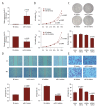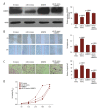MicroRNA-32 Regulates Development and Progression of Hepatocellular Carcinoma by Targeting ADAMTS9 and Affects Its Prognosis
- PMID: 30393368
- PMCID: PMC6237041
- DOI: 10.12659/MSMBR.910522
MicroRNA-32 Regulates Development and Progression of Hepatocellular Carcinoma by Targeting ADAMTS9 and Affects Its Prognosis
Abstract
BACKGROUND MicroRNA-32 (miR-32) induces cell proliferation and metastasis in hepatocellular carcinoma (HCC), but the detailed mechanisms of miR-32 in regulating oncogenesis and development of HCC have not been clarified. The aim of this study was to investigate the effects of miR-32 on HCC and its clinical pathological significance, as well as to determine the functional connection between miR-32 and ADAMTS9 in HCC. MATERIAL AND METHODS Quantitative RT-PCR was used to assess the expression levels of miR-32 in HCC tissues, adjacent non-cancerous tissues, and liver cancer cell lines. In vitro cell proliferation, migration, and invasion assays were performed to confirm the biological functions of miR-32. Quantitative RT-PCR, Western blot analysis, and luciferase reporter assays were used to evaluate the role of miR-32 in the regulation of ADAMTS9. RESULTS miR-32 was highly expressed in HCC tissues compared with corresponding adjacent non-cancerous tissues. Over-expression of miR-32 was also found in 3 human liver cancer cell lines: SMMC-7721, Huh7, and HepG2. Moreover, increasing expression of miR-32 in HCC tissues was related to shorter overall survival. In vitro over-expression of miR-32 promoted cell proliferation, migration, and invasion; however, the under-expression of miR-32 revealed the opposite effects. Dual-luciferase reporter assay indicated that miR-32 can directly bind to the 3'-UTR of ADAMTS9. Western blot analysis showed that over-expression of miR-32 decreased expression of ADAMTS9 protein. Rescue tests further verified the connection between miR-32 and ADAMTS9. CONCLUSIONS Our data indicate that miR-32 accelerates progression in HCC by targeting ADAMTS9, and the abnormal expression of miR-32 is correlated with prognosis and could become a potential therapeutic target.
Conflict of interest statement
None.
Figures





Similar articles
-
MicroRNA-370 Regulates Cellepithelial-Mesenchymal Transition, Migration, Invasion, and Prognosis of Hepatocellular Carcinoma by Targeting GUCD1.Yonsei Med J. 2019 Mar;60(3):267-276. doi: 10.3349/ymj.2019.60.3.267. Yonsei Med J. 2019. PMID: 30799589 Free PMC article.
-
MicroRNA-493 suppresses cell proliferation and invasion by targeting ZFX in human hepatocellular carcinoma.Cancer Biomark. 2018;22(3):427-434. doi: 10.3233/CBM-171036. Cancer Biomark. 2018. PMID: 29758928
-
[The effects of microRNA-7 on proliferation and invasion of hepatocellular carcinoma HepG2 cells].Zhonghua Zhong Liu Za Zhi. 2018 Jun 23;40(6):406-411. doi: 10.3760/cma.j.issn.0253-3766.2018.06.002. Zhonghua Zhong Liu Za Zhi. 2018. PMID: 29936764 Chinese.
-
Progress and prospects of circular RNAs in Hepatocellular carcinoma: Novel insights into their function.J Cell Physiol. 2018 Jun;233(6):4408-4422. doi: 10.1002/jcp.26154. Epub 2017 Sep 28. J Cell Physiol. 2018. PMID: 28833094 Review.
-
The role of miRNA125b in the progression of hepatocellular carcinoma.Clin Res Hepatol Gastroenterol. 2021 Sep;45(5):101712. doi: 10.1016/j.clinre.2021.101712. Epub 2021 Apr 27. Clin Res Hepatol Gastroenterol. 2021. PMID: 33930594 Review.
Cited by
-
ADAMTS8 Inhibits Cell Proliferation and Invasion, and Induces Apoptosis in Breast Cancer.Onco Targets Ther. 2020 Aug 21;13:8373-8382. doi: 10.2147/OTT.S248085. eCollection 2020. Onco Targets Ther. 2020. PMID: 32904790 Free PMC article.
-
ADAMTS9-AS1 Long Non‑coding RNA Sponges miR‑128 and miR-150 to Regulate Ras/MAPK Signaling Pathway in Glioma.Cell Mol Neurobiol. 2023 Jul;43(5):2309-2322. doi: 10.1007/s10571-022-01311-7. Epub 2022 Nov 30. Cell Mol Neurobiol. 2023. PMID: 36449154 Free PMC article.
-
microRNA-548b suppresses aggressive phenotypes of hepatocellular carcinoma by directly targeting high-mobility group box 1 mRNA.Cancer Manag Res. 2019 Jun 25;11:5821-5834. doi: 10.2147/CMAR.S198615. eCollection 2019. Cancer Manag Res. 2019. Retraction in: Cancer Manag Res. 2021 Oct 04;13:7593-7594. doi: 10.2147/CMAR.S341059. PMID: 31417317 Free PMC article. Retracted.
-
miR-32-5p suppresses the progression of hepatocellular carcinoma by regulating the GSK3β/NF-κB signaling.Acta Biochim Biophys Sin (Shanghai). 2025 Apr 1;57(7):1125-1138. doi: 10.3724/abbs.2025038. Acta Biochim Biophys Sin (Shanghai). 2025. PMID: 40170617 Free PMC article.
-
ADAM and ADAMTS Proteins, New Players in the Regulation of Hepatocellular Carcinoma Microenvironment.Cancers (Basel). 2021 Mar 29;13(7):1563. doi: 10.3390/cancers13071563. Cancers (Basel). 2021. PMID: 33805340 Free PMC article. Review.
References
MeSH terms
Substances
LinkOut - more resources
Full Text Sources
Medical

